Acid rain is a type of precipitation with an acidic pH instead of the neutral pH of normal rain. It is caused when pollutants from industrial and car exhaust react with nitric oxide and other chemicals in the atmosphere to form acids, such as sulfuric acid and nitric acid. Although it may seem like this wouldn’t have any impact on rocks or soil, the effects of acid rain on rocks are numerous and significant.
With prolonged exposure to acid rain, rocks begin to decompose and deteriorate. This phenomenon is known as chemical weathering, and it also occurs in nature due to natural sources of acidic precipitation (e.g., fog and mist). When these natural sources combine with man-made pollution, however, the result is accelerated natural erosion that can damage structures containing those rocks (e.g., buildings).
In this article, we will explore how acid rain affects rocks by examining its effects on various types of soils and minerals.
What Does Acid Rain Do To Rocks?

When rain falls from the sky, it naturally contains a small number of hydrogen ions, which are the source of its acidity. Normal rainfall, however, has a pH of around 5.6, which is considered slightly acidic but still safe for the environment. In contrast, acid rain has a pH of 4.0 or lower and contains a much higher concentration of hydrogen ions.
When this acid rain falls on rocks and soil, it reacts with the minerals and rocks in the ground by transferring hydrogen ions. Normally, minerals in rocks and soil have a positive charge, while hydrogen ions have a negative charge. When the acid rain drops come into contact with the minerals, they transfer the hydrogen ions and cause a chemical reaction.
Effect of Acid Rain on Sedimentary Rocks
Sedimentary rocks are formed when minerals and dissolved minerals from the soil are deposited by water. When these rocks are exposed to acid rain, some of the minerals and dissolved minerals are dissolved, causing them to be washed away. By removing the minerals from sedimentary rocks, acid rain accelerates their natural weathering rate. In the long term, this can damage buildings made of sedimentary rocks, such as limestone.
Effect of Acid Rain on Limestone
Limestone is one of the most common sedimentary rocks and is used in a variety of construction materials, including cement, lime, and concrete. When exposed to acid rain, limestone is dissolved and removed from the rocks, which can damage the construction materials made from it. Acid rain can also erode limestone buildings and sculptures over time.
Effect of Acid Rain on Marble
Marble is a type of sedimentary rock that is made of calcium carbonate. This is the same main mineral that can be found in seashells. When marble rocks are exposed to acid rain, the calcium carbonate starts to dissolve and gets washed away. This causes the marble rocks to weaken and eventually break.
Effect of Acid Rain on Granite
Granite is a type of igneous rock formed from hardened magma. The minerals in granite are very resistant to weathering and erosion. However, when exposed to acid rain, the acids in the rain can dissolve the minerals in granite.
This weakens the rock and makes it more susceptible to erosion. The acid rain can then cause the granite to erode, which can damage structures made of granite, such as bridges and buildings.
Effect of Acid Rain on Shale and Mudstone
Shale is a type of sedimentary rock that is made of minerals that are dissolved in water. When exposed to acid rain, the minerals are dissolved and removed from the rock, which weakens it and causes it to break.
Mudstone is also a type of sedimentary rock that is made of minerals that are dissolved in water. When mudstone is exposed to acid rain, the minerals are dissolved and removed from the rock, which weakens it and makes it more susceptible to breaking.
Effect of Acid Rain on Solid Rock
When acid rain falls on a solid rock like a cliff or a mountain, it can cause the minerals in the rock to dissolve. This is because the hydrogen ions in the acid react with the minerals in the rock. The process of weathering and erosion can take months or years, and over time it can weaken the rock and make it more likely to crumble or break. Once the minerals are dissolved, the rocks begin to erode and break down, which can cause damage to the landscape.
Summing up
Acid rain is a type of precipitation with an acidic pH caused by pollutants from industrial and car exhaust reacting with nitric oxide and other chemicals in the atmosphere to form acids, such as sulfuric acid and nitric acid. When this acid rain falls on rocks and soil, it reacts with the minerals and rocks in the ground by transferring hydrogen ions.
Normally, minerals in rocks and soil have a positive charge, while hydrogen ions have a negative charge. When the acid rain drops come into contact with the minerals, they transfer the hydrogen ions and cause a chemical reaction. When hydrogen ions are transferred to rocks and soil, they can cause a significant amount of damage, including the dissolution of minerals, the weakening and crumbling of rocks, and the erosion of solid rock.
Additional Contents

